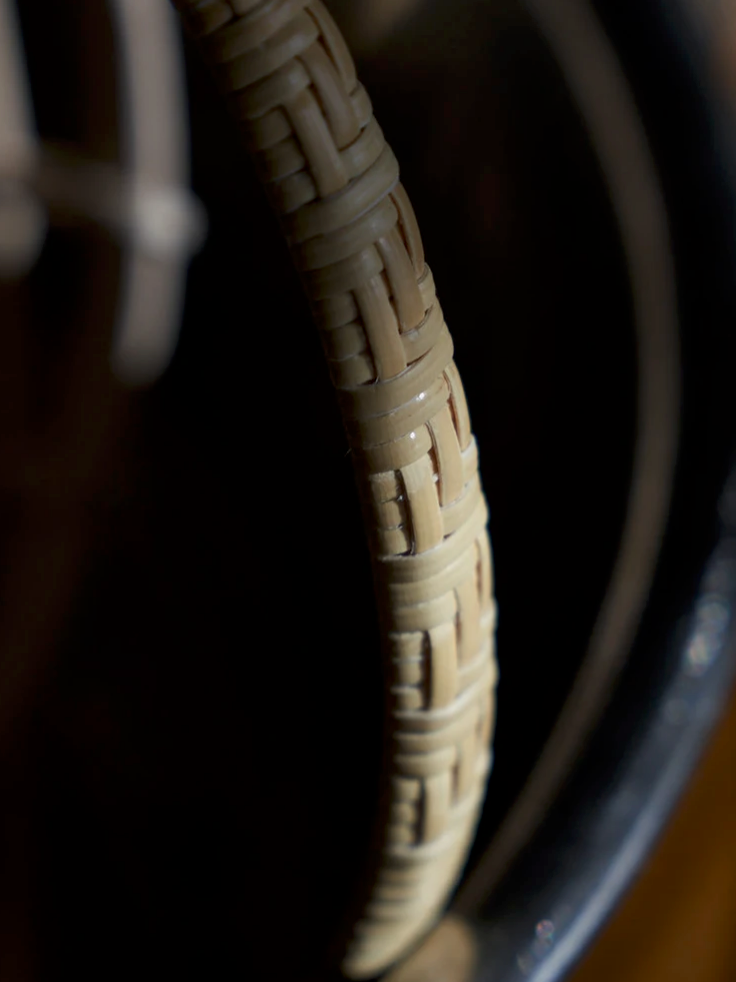Breathing rattan, with its vitality in hand
2019.03.01
Glass, rattan, mother-of-pearl... SIRI SIRI jewelry is made from materials found in our daily lives. In the series "A Journey to Materials," we delve into perspectives that create new value while uncovering the origins and characteristics of materials.
-
Rattan is often used for furniture such as chairs because of its lightness, toughness, and flexibility. Yasuko Okayasu, a rattan craftsman who works on SIRI SIRI's ARABESQUE series, told me that "rattan is the longest plant in the world, and the longest one can reach 200m."
Rattan gives a soft impression when it comes to products, but the growing appearance is quite wild. A plant of the palm family that grows naturally in tropical rainforests, it is a climbing plant that is about 2 to 5 cm thick and has sharp thorns on its surface.

It is said that there are about 600 types, but only a few of them are suitable for furniture and rattan work. Most of the rattan imported into Japan comes from Indonesia and other Southeast Asian countries and is processed by hand, but due to excessive logging and development, high-quality rattan is now becoming a rarity. “They now spend a week going deep into the mountains to get them,” says Okayasu, thinking about the hardships of the local people.
"That's why we have to handle materials carefully, and I want to make things that can be used for a long time."
The charm of rattan brought out by human hands

The use of rattan in daily life has a long history, and there are ancient records of the use of rattan stools in ancient Egypt. In Japan, it was already used in the Heian period, and it is said that it was used for chairs, baskets, and bows. Rattan chairs were also highly prized in Europe, and Louis XIII and Louis XIV loved rattan chairs.
The reason why rattan, which only grows in tropical rainforest regions, has been used all over the world is because its fiber is said to be the strongest of all plants, and because it is easy to process. However, rattan cannot be used just by cutting it down. First, the man makes a ring of 5 to 6m rattan and takes it down from the mountain, then the woman stretches it out to dry, and the man heats it further and bends it. It is used as it is for the frames of chairs and sofas, but most of it is further processed and used as a material for handicrafts.
The kawato, with the skin removed, can be wrapped around joints to reinforce them, or woven for a variety of purposes. The peeled core (round core) is also processed into strips and used as a raw material. Depending on the cross section, there are types such as round core, half core, and flat core, and various shapes can be created by combining and weaving.
“The pierced earrings are made with a thin round core, which is tied into an Awaji knot,” says Mr. Okayasu as he knits the pierced earrings in a flowing manner. Because rattan is flexible, it can be woven into complicated knots. Then he showed me how to weave a basket. The round core used for the basket is thicker than the pierced one, and it takes strength to weave it. “It takes a lot of strength, but rattan makes it possible to weave even this thick material freely. This is not possible with other materials,” says Okayasu. When you actually touch it, it certainly takes some force, but it bends surprisingly obediently and draws a beautiful curve.
Another reason why strong rattan is soft is due to its ability to absorb water. When rattan absorbs water, it softens and becomes easier to work with, so it is said to be soaked in water before weaving. And the wet and bent rattan keeps its shape even when it dries. This feature enables complex rattan work.
Even without soaking in water, rattan absorbs and exhales moisture from the air, which Okayasu describes as "breathing." If you look at the cross section, there are many fine holes. These holes act like straws to suck up water and absorb moisture. Taking advantage of this characteristic, rattan is often used for aroma sticks.
Even if it becomes rattan work, this original characteristic of the plant is not lost. That's why rattan continues to breathe even when it becomes earrings or baskets. It is often said that the craftsman breathes life into things, but in the case of rattan, it may be that the maker's use of the inherent vitality of rattan reveals that power.

Rattan, a wild jungle plant, transforms into soft, beautiful, and lifelike crafts.
The greatest attraction of rattan material is its vitality, and it is accompanied by the hands of many people who gently hand over that vitality to us.
Written by Kenji Ishimura
Photo Go Itami


